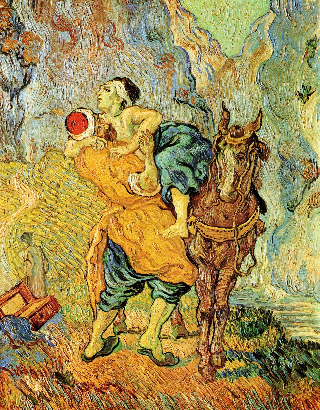The Gospel reading of the Man born blind is easily my favorite Scriptural text (John 9. 1-41). Notice how it starts without the man asking for anything. Instead, while his disciples are wondering why the man is born blind, Jesus puts mud on the poor man’s eyes, and tells him to wash. The man returns cured. But that’s just the beginning of the story. In the meantime, Jesus exits. The leaders want to know how did this man get cured. Here’s where things get dicey for the man. By the end of the story, his frightened parents distance themselves from him and the temple leaders expel him. He’s off on his own. Throughout the text, he’s incredibly impressive, testifying on his own, on each occasion, with greater confidence about who Jesus is and what Jesus has done for him. By the end he has grown in such courage, wisdom, and faith that he turns the tables and begins to question those questioning him. It’s a tour-de-force for the man born blind. But he gets thrown out of the Temple. Finally Jesus returns, having learned that the man born blind has been expelled. He finds the man and reveals…
I think of Lent as a training period to develop our capacity for vulnerability, recognition and accompaniment. My last three blog entries have been on vulnerability. Recognition was implicit throughout those earlier claims but now it’s time to make it explicit. Earlier we saw that that the Good Samaritan’s vulnerability becomes apparent when he recognizes and then accompanies the wounded man. Recognition and vulnerability go hand in hand in that parable as well as in the parable of the Prodigal Son as the father’s vulnerability to his two sons becomes evident through recognition and response. While recognizing his younger son’s prodigal request for mercy and reconciliation, he also recognizes the older son’s resistance to recognizing his own brother: in speaking to his father the older one refers to his brother as “this son of yours,” but the father entreats the older one to recognize that his son is this man’s brother: “this brother of yours was dead and has come to life.” (Luke 15.32). Vulnerability inevitably has as its first response recognition. The failure to recognize, as in the Rich Man and Lazarus (Luke 16: 19-31), is the beginning of the path of perdition. Not surprisingly then in the…
When we think of being in the image of God we might think of the Sistine Chapel where the figure of Adam on the ceiling just about to be awakened by the touch of God bears an identical image of the Judge and the Lord of the Resurrection on the back wall. Michelangelo’s Adam bears the face of Christ, the Alpha and Omega. We, Adam, are in the image of the one who has conquered sin and death. But there is another, more original, let’s call it “vulnerable” image that connects the creation of Adam with the birth of Jesus. In the twenty-first chapter of T.H. White’s wonderful The Once and Future King (Ace Books, New York 1987), we read a memorable account of creation. On the fifth and sixth days of creation, God gathers all the embryos of each and every species of animal life and offers each embryo a wish for something extra. The giraffe embryo gets a long neck for tree food, the porcupine asks for quills for protection, and so it goes for the entire animal kingdom. At the end of the entire ordeal, the last embryo is the human who when asked by God…
On September 27th I offered the Father of the Prodigal son for reflection as a model of capacious vulnerability. My comments on vulnerability last month might have surprised the reader who thinks of vulnerability primarily as the condition that raises alarm, concern, or the need to protect. I think of vulnerability, however, as that innate capacity we have to respond to the other who is at risk. Now I would like to take that insight further in a reflection on the Good Samaritan (Luke 10: 29-37). It is important for us to remember why Jesus tells this parable. He has just given the commandment to love one another. In response, one of the Scribes asked Jesus, “Who is my neighbor?” A close reading of the story reveals that Jesus is offering a very surprising answer to the question. At the beginning of the story we are thinking that the answer to the question “who is my neighbor?” is the man lying wounded on the road, that is, the precarious one. But by the end of the story we are no longer looking for the neighbor as the precarious one but at the vulnerable one who is acting. The Scribe rightly…
My recent interests have been to establish a fundamental ethics based on vulnerability. I believe that our vulnerability derives from the nature of God in whose image we are made; made in the image of the vulnerable God, vulnerability is our nature. I believe that vulnerability is what establishes us as creatures before God and one another. I believe that being vulnerable is where the moral life starts. Besides being influenced by Irish theologians, Enda McDonagh and Linda Hogan, I have been borrowing some insights from the philosopher Judith Butler who has herself borrowed from Emmanuel Levinas, among others. Butler roots all of ethics in vulnerability. For Butler vulnerability «is prior to any individual sense of self… and this is what it means to be the self I am, receptive to you in ways that I cannot fully predict or control». She writes: «You call upon me, and I answer. But if I answer, it was only because I was already answerable; that is, this susceptibility and vulnerability constitutes me at the most fundamental level and is there, we might say, prior to any deliberate decision to answer the call. In other words, one has to be already capable of…





